Page 61 of 354
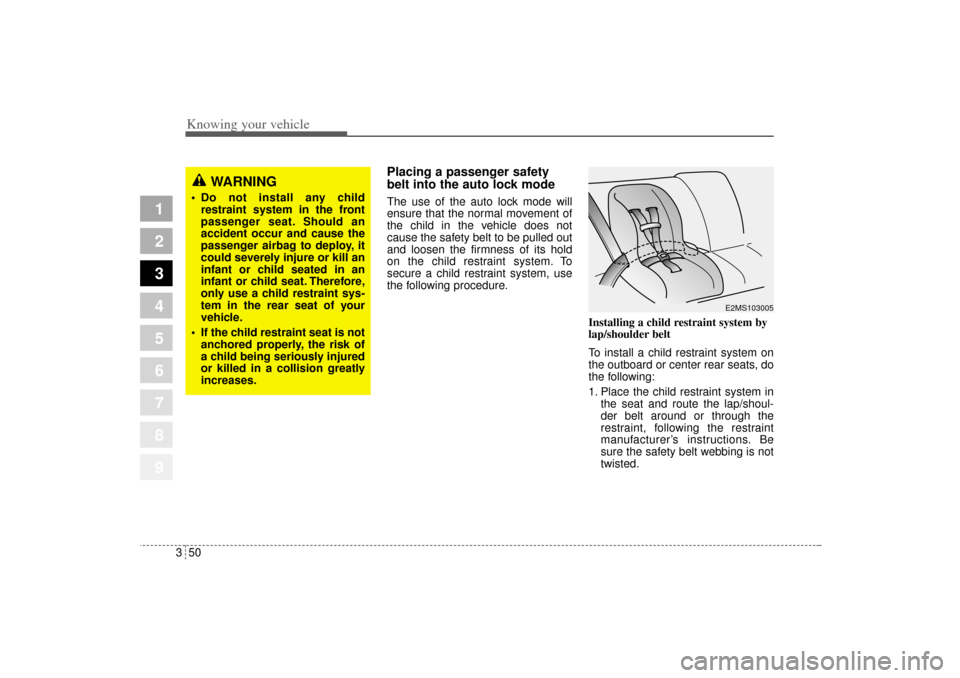
Knowing your vehicle50 3
1
2
3
4
5
6
7
8
9
Placing a passenger safety
belt into the auto lock modeThe use of the auto lock mode will
ensure that the normal movement of
the child in the vehicle does not
cause the safety belt to be pulled out
and loosen the firmness of its hold
on the child restraint system. To
secure a child restraint system, use
the following procedure.
Installing a child restraint system by
lap/shoulder belt
To install a child restraint system on
the outboard or center rear seats, do
the following:
1. Place the child restraint system in
the seat and route the lap/shoul-
der belt around or through the
restraint, following the restraint
manufacturer’s instructions. Be
sure the safety belt webbing is not
twisted.
WARNING
Do not install any child
restraint system in the front
passenger seat. Should an
accident occur and cause the
passenger airbag to deploy, it
could severely injure or kill an
infant or child seated in an
infant or child seat. Therefore,
only use a child restraint sys-
tem in the rear seat of your
vehicle.
If the child restraint seat is not
anchored properly, the risk of
a child being seriously injured
or killed in a collision greatly
increases.
E2MS103005
KM CAN (ENG) 3 (~57).qxd 9/13/2004 4:49 PM Page 50
Page 62 of 354
351
Knowing your vehicle
1
2
3
4
5
6
7
8
9
2. Fasten the lap/shoulder belt latch
into the buckle. Listen for the dis-
tinct “click” sound.Position the release button so that it
is easy to access in case of an
emergency.
3. Pull the shoulder portion of the
safety belt all the way out. When
the shoulder portion of the safety
belt is fully extended, it will shift
the retractor to the “Auto Lock”
(child restraint) mode.4. Slowly allow the shoulder portion
of the safety belt to retract and lis-
ten for an audible “clicking” or
“ratcheting” sound. This indicates
that the retractor is in the “Auto
Lock” mode. If no distinct sound is
heard, repeat steps 3 and 4.
E2BLD310
"Click"
MMSA3029
MMSA3028
KM CAN (ENG) 3 (~57).qxd 9/13/2004 4:49 PM Page 51
Page 63 of 354
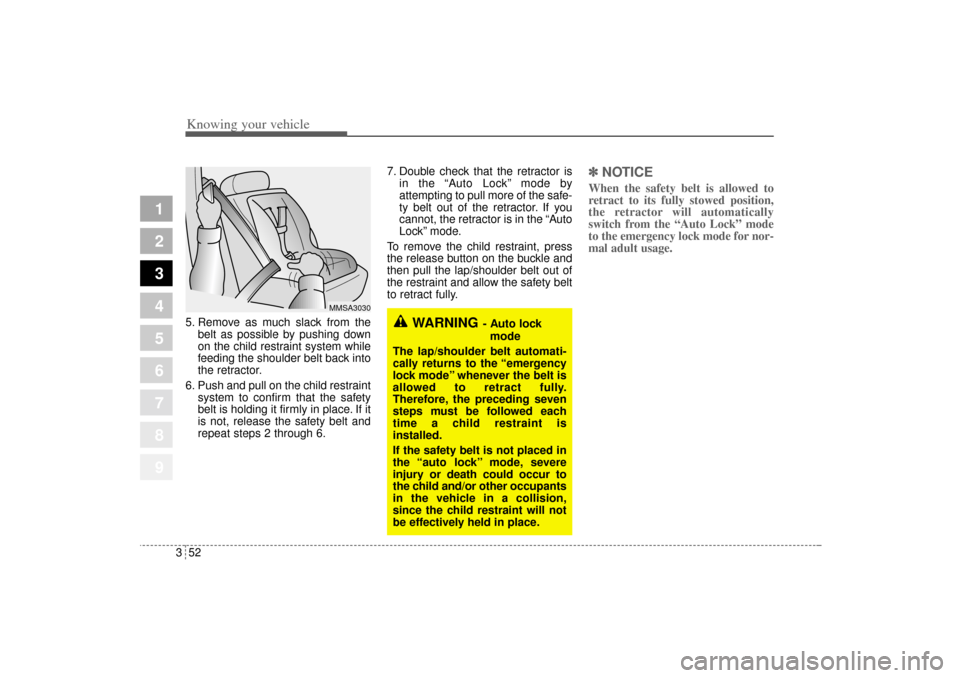
Knowing your vehicle52 3
1
2
3
4
5
6
7
8
9
5. Remove as much slack from the
belt as possible by pushing down
on the child restraint system while
feeding the shoulder belt back into
the retractor.
6. Push and pull on the child restraint
system to confirm that the safety
belt is holding it firmly in place. If it
is not, release the safety belt and
repeat steps 2 through 6.7. Double check that the retractor is
in the “Auto Lock”mode by
attempting to pull more of the safe-
ty belt out of the retractor. If you
cannot, the retractor is in the “Auto
Lock”mode.
To remove the child restraint, press
the release button on the buckle and
then pull the lap/shoulder belt out of
the restraint and allow the safety belt
to retract fully.
✽ ✽
NOTICEWhen the safety belt is allowed to
retract to its fully stowed position,
the retractor will automatically
switch from the “Auto Lock” mode
to the emergency lock mode for nor-
mal adult usage.
MMSA3030
WARNING
- Auto lock
mode
The lap/shoulder belt automati-
cally returns to the “emergency
lock mode” whenever the belt is
allowed to retract fully.
Therefore, the preceding seven
steps must be followed each
time a child restraint is
installed.
If the safety belt is not placed in
the “auto lock” mode, severe
injury or death could occur to
the child and/or other occupants
in the vehicle in a collision,
since the child restraint will not
be effectively held in place.
KM CAN (ENG) 3 (~57).qxd 9/13/2004 4:49 PM Page 52
Page 64 of 354
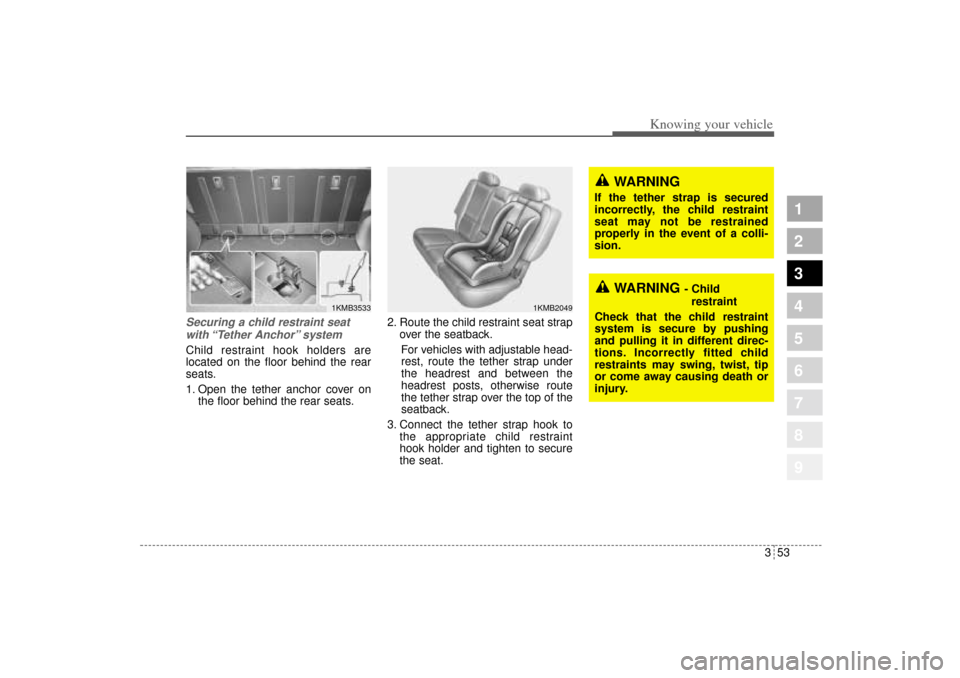
353
Knowing your vehicle
1
2
3
4
5
6
7
8
9
Securing a child restraint seat
with “Tether Anchor” system Child restraint hook holders are
located on the floor behind the rear
seats.
1. Open the tether anchor cover on
the floor behind the rear seats.2. Route the child restraint seat strap
over the seatback.
For vehicles with adjustable head-
rest, route the tether strap under
the headrest and between the
headrest posts, otherwise route
the tether strap over the top of the
seatback.
3. Connect the tether strap hook to
the appropriate child restraint
hook holder and tighten to secure
the seat.
1KMB2049
1KMB3533
WARNING
If the tether strap is secured
incorrectly, the child restraint
seat may not be restrained
properly in the event of a colli-
sion.
WARNING
- Child
restraint
Check that the child restraint
system is secure by pushing
and pulling it in different direc-
tions. Incorrectly fitted child
restraints may swing, twist, tip
or come away causing death or
injury.
KM CAN (ENG) 3 (~57).qxd 9/13/2004 4:49 PM Page 53
Page 65 of 354
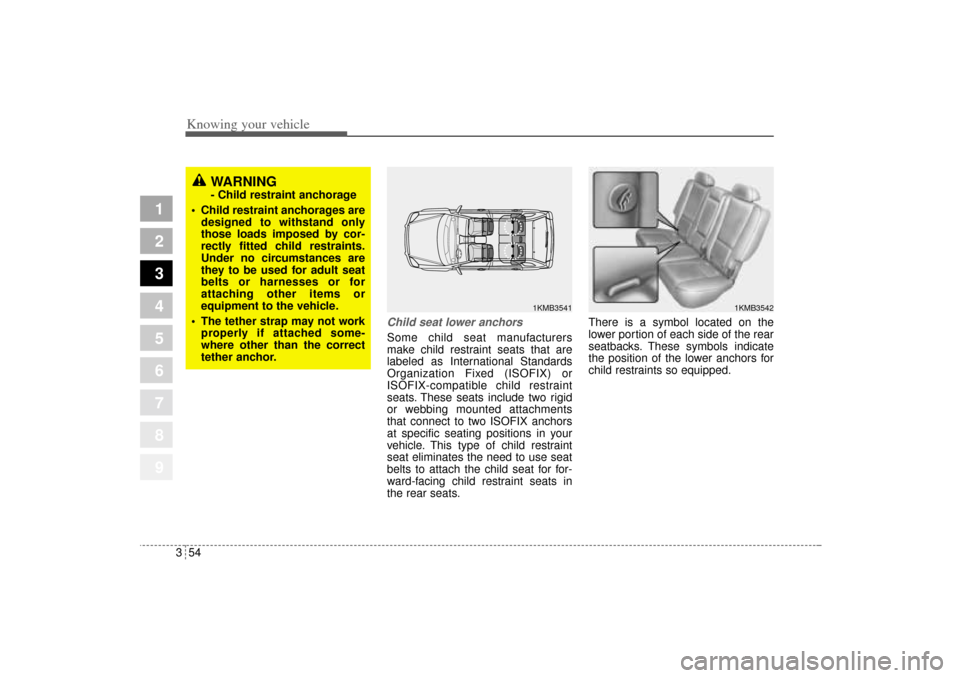
Knowing your vehicle54 3
1
2
3
4
5
6
7
8
9
Child seat lower anchorsSome child seat manufacturers
make child restraint seats that are
labeled as International Standards
Organization Fixed (ISOFIX) or
ISOFIX-compatible child restraint
seats. These seats include two rigid
or webbing mounted attachments
that connect to two ISOFIX anchors
at specific seating positions in your
vehicle. This type of child restraint
seat eliminates the need to use seat
belts to attach the child seat for for-
ward-facing child restraint seats in
the rear seats.There is a symbol located on the
lower portion of each side of the rear
seatbacks. These symbols indicate
the position of the lower anchors for
child restraints so equipped.
1KMB3541
1KMB3542
WARNING - Child restraint anchorage
Child restraint anchorages are
designed to withstand only
those loads imposed by cor-
rectly fitted child restraints.
Under no circumstances are
they to be used for adult seat
belts or harnesses or for
attaching other items or
equipment to the vehicle.
The tether strap may not work
properly if attached some-
where other than the correct
tether anchor.
KM CAN (ENG) 3 (~57).qxd 9/13/2004 4:50 PM Page 54
Page 66 of 354
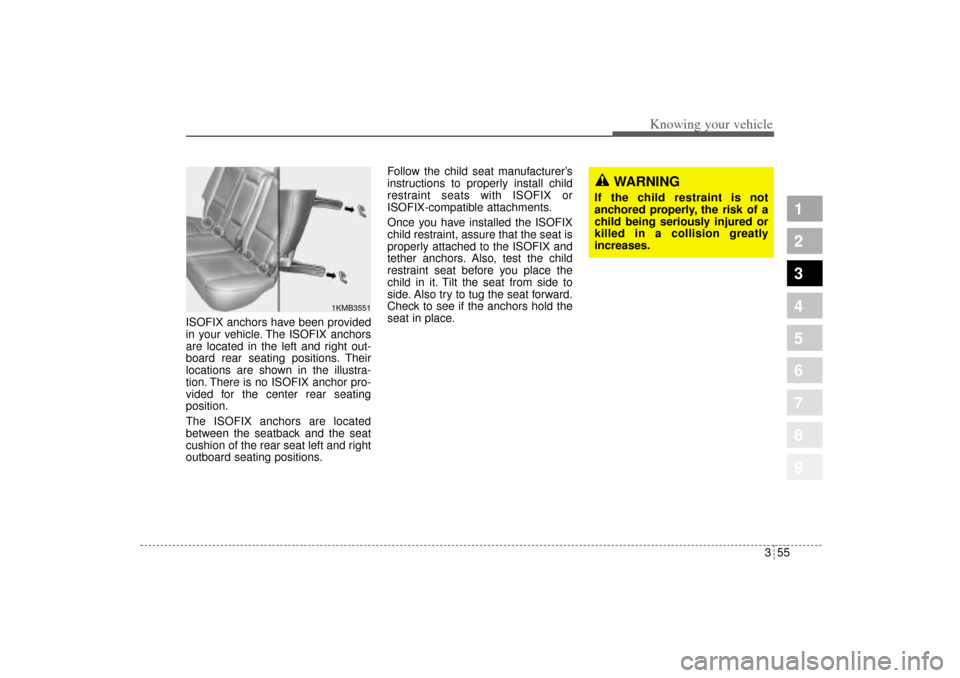
355
Knowing your vehicle
1
2
3
4
5
6
7
8
9
ISOFIX anchors have been provided
in your vehicle. The ISOFIX anchors
are located in the left and right out-
board rear seating positions. Their
locations are shown in the illustra-
tion. There is no ISOFIX anchor pro-
vided for the center rear seating
position.
The ISOFIX anchors are located
between the seatback and the seat
cushion of the rear seat left and right
outboard seating positions.Follow the child seat manufacturer’s
instructions to properly install child
restraint seats with ISOFIX or
ISOFIX-compatible attachments.
Once you have installed the ISOFIX
child restraint, assure that the seat is
properly attached to the ISOFIX and
tether anchors. Also, test the child
restraint seat before you place the
child in it. Tilt the seat from side to
side. Also try to tug the seat forward.
Check to see if the anchors hold the
seat in place.
1KMB3551
WARNING
If the child restraint is not
anchored properly, the risk of a
child being seriously injured or
killed in a collision greatly
increases.
KM CAN (ENG) 3 (~57).qxd 9/13/2004 4:50 PM Page 55
Page 67 of 354
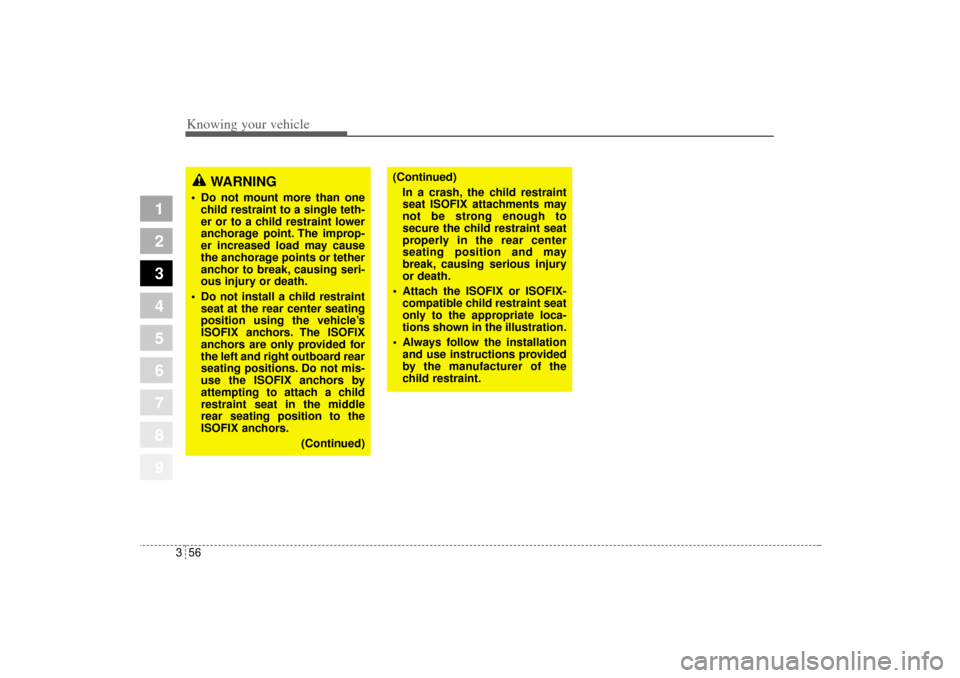
Knowing your vehicle56 3
1
2
3
4
5
6
7
8
9
(Continued)
In a crash, the child restraint
seat ISOFIX attachments may
not be strong enough to
secure the child restraint seat
properly in the rear center
seating position and may
break, causing serious injury
or death.
Attach the ISOFIX or ISOFIX-
compatible child restraint seat
only to the appropriate loca-
tions shown in the illustration.
Always follow the installation
and use instructions provided
by the manufacturer of the
child restraint.
WARNING
Do not mount more than one
child restraint to a single teth-
er or to a child restraint lower
anchorage point. The improp-
er increased load may cause
the anchorage points or tether
anchor to break, causing seri-
ous injury or death.
Do not install a child restraint
seat at the rear center seating
position using the vehicle’s
ISOFIX anchors. The ISOFIX
anchors are only provided for
the left and right outboard rear
seating positions. Do not mis-
use the ISOFIX anchors by
attempting to attach a child
restraint seat in the middle
rear seating position to the
ISOFIX anchors.
(Continued)
KM CAN (ENG) 3 (~57).qxd 9/13/2004 4:50 PM Page 56
Page 75 of 354
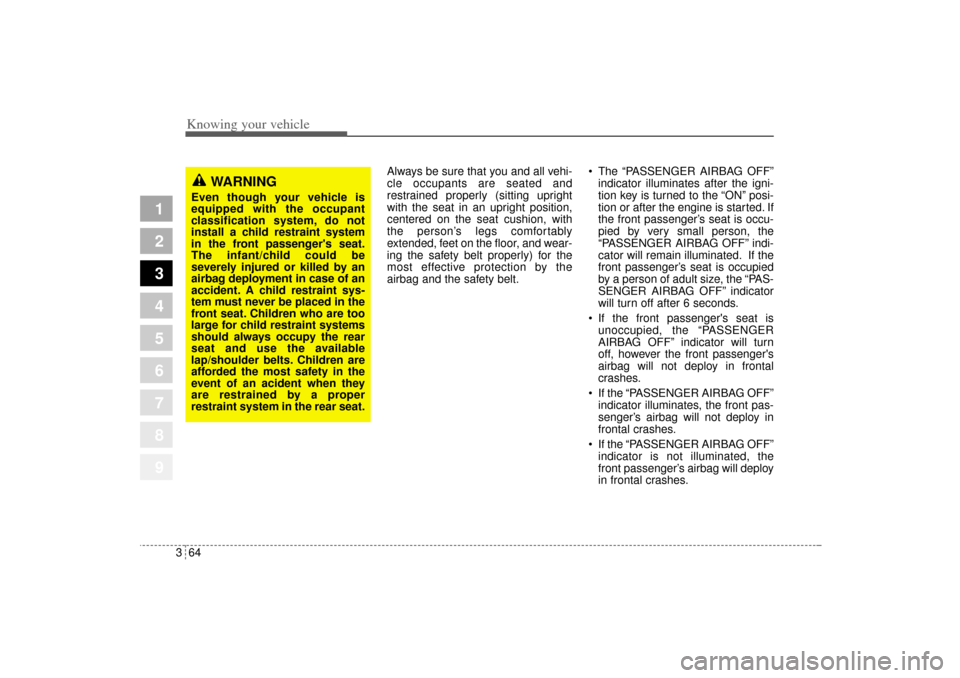
Knowing your vehicle64 3
1
2
3
4
5
6
7
8
9
Always be sure that you and all vehi-
cle occupants are seated and
restrained properly (sitting upright
with the seat in an upright position,
centered on the seat cushion, with
the person’s legs comfortably
extended, feet on the floor, and wear-
ing the safety belt properly) for the
most effective protection by the
airbag and the safety belt. The “PASSENGER AIRBAG OFF”
indicator illuminates after the igni-
tion key is turned to the “ON” posi-
tion or after the engine is started. If
the front passenger’s seat is occu-
pied by very small person, the
“PASSENGER AIRBAG OFF” indi-
cator will remain illuminated. If the
front passenger’s seat is occupied
by a person of adult size, the “PAS-
SENGER AIRBAG OFF” indicator
will turn off after 6 seconds.
If the front passenger's seat is
unoccupied, the “PASSENGER
AIRBAG OFF” indicator will turn
off, however the front passenger's
airbag will not deploy in frontal
crashes.
If the “PASSENGER AIRBAG OFF”
indicator illuminates, the front pas-
senger’s airbag will not deploy in
frontal crashes.
If the “PASSENGER AIRBAG OFF”
indicator is not illuminated, the
front passenger’s airbag will deploy
in frontal crashes.
WARNING
Even though your vehicle is
equipped with the occupant
classification system, do not
install a child restraint system
in the front passenger's seat.
The infant/child could be
severely injured or killed by an
airbag deployment in case of an
accident. A child restraint sys-
tem must never be placed in the
front seat. Children who are too
large for child restraint systems
should always occupy the rear
seat and use the available
lap/shoulder belts. Children are
afforded the most safety in the
event of an acident when they
are restrained by a proper
restraint system in the rear seat.
KM CAN (ENG) 3 (~112).qxd 9/13/2004 4:50 PM Page 64